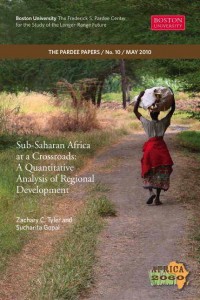The Pardee Papers, No. 10, May 2010
 Sub-Saharan Africa at a Crossroads: A Quantitative Analysis of Regional Development
Sub-Saharan Africa at a Crossroads: A Quantitative Analysis of Regional Development
By Zachary C. Tyler and Sucharita Gopal
May 2010 (32 pages)
IBSN 978-0-9825683-4-7
Download PDF
Sub-Saharan Africa is at a crossroads of development. Despite a quarter of a century of economic reforms propagated by national policies and international financial agencies and institutions, sub-Saharan Africa is still lagging in development. In this paper, the authors adopt two techniques using both qualitative (e.g. governance) and quantitative factors (e.g., GDP) to examine regional patterns of development in sub-Saharan Africa. More specifically, they examine and analyze similarities and differences among the countries in this region using a multivariate statistical technique, Principal Component Analysis (PCA), and a unsupervised neural network called Kohonen’s Self-Organizing Map (SOM) to cluster levels of development. PCA serves as a tool for determining regional patterns while SOM is more useful for determining continental patterns in development. Both PCA and SOM results show a “developed” cluster in Southern Africa (South Africa, Namibia, Botswana, and Gabon). SOM exhibits a cluster of least developed countries in southern Western Africa and western Central Africa. The results demonstrate that the applied techniques are highly effective to compress multidimensional qualitative and quantitative data sets to extract relevant information about development from a policy perspective. Our analysis indicates the significance of governance variables in some clusters while a combination of variables explains other regional clusters.
Zachary Tyler works for a consulting firm in Massachusetts that conducts program evaluations for energy efficiency programs, and he continues to work on statistical and geospatial analyses of human development issues. In 2010, he will receive a master’s degree in energy and environmental analysis from Boston University.
Sucharita Gopal is Professor and Director of Graduate Studies in the Department of Geography and Environment and a member of the Cognitive & Neural Systems (CNS) Technology Lab at Boston University. She teaches and conducts research in geographical information systems (GIS), spatial analysis and modeling, and remote sensing for environmental and public health applications. Her recent research includes the development of a marin integrated decision analysis system (MIDAS) for Belize, Panama, and Massachusetts, and a post-disaster geospatial risk model for Haiti.
This paper is part of the Africa 2060 Project, a Pardee Center program of research, publications, and symposia exploring African futures in various aspects related to development on continental and regional scales. For more information, visit www-staging.bu.edu/pardee/research/ .